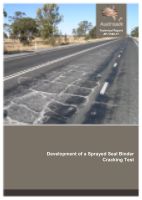Pavement

- Publication no: AP-T326-17
- ISBN: 978-1-925671-06-3
- Published: 12 September 2017
- PDF (free) Download
This report describes research into development of a laboratory sprayed seal binder cracking test which can be used to measure the relative fatigue cracking resistance of thin binder films which have thicknesses comparable to the thicknesses of the binder films in sprayed seals (1–3 mm).
Initial studies involved optimising the experimental equipment and test conditions used in a prototype sprayed seal binder cracking test which was developed during Austroads project TT1820 Maximising the Performance of Sprayed Seals. Once the test conditions were optimised, the results obtained in the test were verified by comparing the results obtained for a series of 4 bitumen samples and 12 polymer modified binders (PMBs) with the conventional asphalt fatigue life results obtained after each of the materials was incorporated into a single type of 10 mm dense graded asphalt mix. A very good correlation was found between sprayed seal cracking test fatigue life results and conventional asphalt fatigue life results.
The results obtained in sprayed seal binder cracking tests and asphalt fatigue tests during the study and Austroads project TT1823 Binder Characterisation Properties for Enhanced Performancewere also compared with the results obtained in two prospective binder quality control tests (i.e. force ratio and stress ratio tests) which could be included in the Australian PMB specification in the future. Based on these comparisons, both quality control tests appear to be suitable for ranking the low temperature cracking performance of Australian PMBs when they are used in sprayed sealing and asphalt applications. Stress ratio tests appear to be more versatile than force ratio tests as they are able to effectively characterise a wider range of Australian PMBs.
The results obtained in the study indicated that sprayed seal binder cracking tests were suitable for characterising the fatigue cracking performance of thin films of unaged (i.e. fresh) binders. Further optimisation work appears to be needed to find suitable test conditions to characterise the properties of laboratory aged binders.
- Summary
- 1. Introduction
- 2. Background and Current Project Work
- 2.1. Previous Research into the Development of Tests to Rank Binder Low Temperature Cracking Performance
- 2.1.1. Australian, South African and New Zealand Studies into Sprayed Seal Cracking/Fatigue Tests
- 2.1.2. Other Overseas Studies into the Cracking Performance of Binders
- 2.2. Preliminary Investigations into the Development of a Sprayed Seal Binder Cracking Test Conducted in Austroads Project TT1820
- 2.2.1. Conventional Asphalt Fatigue Tests
- 2.2.2. Feasibility Study Experimental Method
- 2.2.3. Feasibility Study Experimental Results
- 2.2.4. Improvements to the Test
- 2.3. This Report
- 3. Review of the Development of the Fast Fraass Test
- 3.1. The Conventional Fraass Breaking Point Test
- 3.2. Development of the Fast Fraass Test in Australia
- 3.3. Later Austroads Research into a Quality Control Test to Rank the Low Temperature Cracking Performance of Binders
- 3.4. Summary
- 4. Sprayed Seal Binder Cracking Test Optimisation Studies
- 4.1. Modifications to the Test Jig
- 4.2. Modifications to the Binder Film Formation Process
- 4.3. Assessment of Different Types of Split Metal Beams
- 4.4. Effects of Binder Film Thickness
- 4.5. Preliminary Experiments Using a Representative Sample of PAV-aged Binder
- 4.6. Summary
- 5. Sample Preparation and Other Characterisation Tests
- 5.1. Binder Sample Preparation Methods
- 5.2. Asphalt Mix Design Used for Fatigue Tests
- 5.3. Force Ratio Tests
- 5.4. Stress Ratio Tests
- 6. Comparisons between Cracking Test Results and Asphalt Fatigue Results
- 6.1. Binder Samples from Austroads Project TT1823
- 6.2. Coober Pedy Trial Binder Samples
- 6.3. Cooma Trial Binder Samples
- 6.4. All Samples
- 6.5. Discussion
- 7. Comparisons between Fatigue Life Behaviour and Force/Stress Ratio Tests
- 7.1. Force Ratio and Stress Ratio Test Results
- 7.2. Comparisons with Asphalt Fatigue Life Behaviour
- 7.3. Comparisons with Sprayed Seal Binder Cracking Test Behaviour
- 7.4. Discussion
- 8. Conclusions
- References
- Appendix A Conventional Binder Test Results Obtained for the Materials Studied
